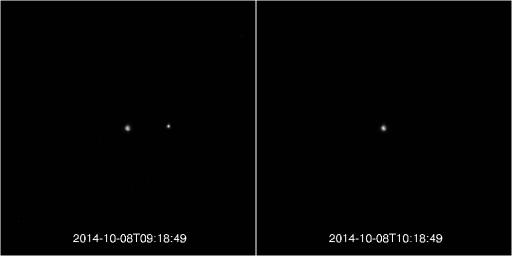
|
Lunar Eclipse, as Viewed by MESSENGER!
- Click the image above for a larger view
- Full-Res JPEG (1028 x 514) (19.7 kB)
- Full-Res TIFF (1028 x 514) (529.2 kB)
Caption:
As millions of people observed the total lunar eclipse on October 8, 2014, MESSENGER was also watching. From Mercury, the Earth and Moon normally appear as if they were two very bright stars. During a lunar eclipse, the Moon seems to disappear during its passage through the Earth's shadow, as shown in the two frames above.
CLICK HERE TO WATCH A MOVIE OF THE LUNAR ECLIPSE!
This movie was constructed from 31 images taken two minutes apart, from 9:18 UTC to 10:18 UTC. The images start just before the Moon entered the darkest part of the Earth's shadow (the umbra).
MESSENGER was 107 million kilometers (66 million miles) from the Earth at the time of the lunar eclipse. The Earth is about 5 pixels across and the Moon is just over 1 pixel across in the field of view of the NAC, with about 40 pixels distance between them. The images are zoomed by a factor of two and the Moon's brightness has been increased by a factor of about 25 to show its disappearance more clearly.
Date acquired:
October 8, 2014
Instrument:
Narrow Angle Camera (NAC) of the Mercury Dual Imaging System (MDIS)
Background Info:
The MESSENGER spacecraft is the first ever to orbit the planet Mercury, and the spacecraft's seven scientific instruments and radio science investigation are unraveling the history and evolution of the Solar System's innermost planet. During the first two years of orbital operations, MESSENGER acquired over 150,000 images and extensive other data sets. MESSENGER is capable of continuing orbital operations until early 2015.
For information regarding the use of images, see the MESSENGER image use policy .
Cataloging Keywords:
| Name | Value | Additional Values |
|---|---|---|
| Target | Mercury | |
| System | ||
| Target Type | Planet | |
| Mission | MESSENGER | |
| Instrument Host | MESSENGER | |
| Host Type | Orbiter | |
| Instrument | Mercury Dual Imaging System (MDIS) | |
| Detector | Narrow Angle Camera (NAC) | |
| Extra Keywords | Eclipse, Grayscale, Moon, Radio, Shadow | |
| Acquisition Date | ||
| Release Date | 2014-10-10 | |
| Date in Caption | 2014-10-08 | |
| Image Credit | NASA/Johns Hopkins University Applied Physics Laboratory/Carnegie Institution of Washington | |
| Source | photojournal.jpl.nasa.gov/catalog/PIA18739 | |
| Identifier | PIA18739 | |
